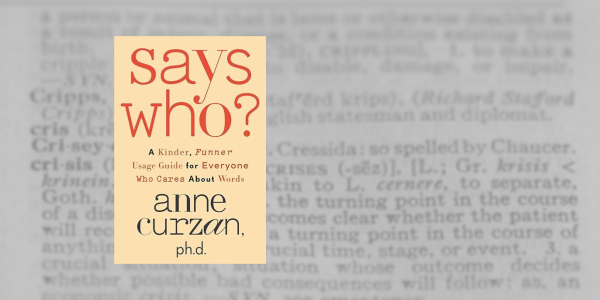A book to appease your inner grammarian

My “favorite books about language” list just got longer with the addition of the new book by Anne Curzan, Says Who: a Kinder, Funner Usage Guide for Everyone Who Cares About Words.
The “Funner” in the subtitle signals that this is not a proper, prescriptive book about grammar. Anything but! It’s a fun romp through the lessons and rules that may have haunted you for years — the wiggly lines inserted by grammar checkers, the voice of your fifth-grade teacher correcting your grammar, even the suggestions made by professional editors.
If you’ve ever despaired over where to put commas or felt guilty about accidentally misplacing an apostrophe, you need this book. If you climb up onto your high horse when you spot “incorrect” capitalization or split infinitives in others’ work, you also need this book.
Curzan starts by setting up a dichotomy between the forces of stability/correctness in language and those of change. She identifies two useful personas:
- Grammarians want writers and speakers to follow the rules. They cling to what they learned—even if years ago—and keep industry style guides within easy reach.
- Wordies relish the fact that language is a living improvisation and means of communication, varied and adaptable. They are curious about changes in usage and the links between words and identity.
Both grammarians and wordies can reside in the same person—I confess to embodying both, although not at the same time. Curzan, a professor of Linguistics, encourages us to balance the care of a grammarian with the curiosity of a wordie.
What you’ll find in these pages
The book tackles all the hot-button topics: Its vs. it’s; who vs. whom; split infinitives; the singular they.
With each issue, Curzan exposes thorny confusions and changing standards. She digs up our pet peeves to expose their tangled roots. That “new trend” you’ve been railing against might have been around since Shakespeare’s time.
Each topic becomes a lesson in how language evolves and the eternal struggle between change and stasis.
This book shifted my perspective on the role that book and newspaper editors play in shaping the language—although they cannot hold back the strong currents of usage changes.
The overarching lesson? Embrace tolerance and curiosity. Be careful when you get overly judgemental about usage. As Curzan tells us, “Debates about language are almost always about more than language.”
So. Much. Fun.
I enjoyed discovering how words and usage trends have shifted in my own lifetime without my noticing: for example, how the verb sneak gained a new, irregular past tense (snuck). That snuck up on me!
Curzan’s voice is warm and witty rather—like a true “word nerd” friend.
Reading this makes me feel better about my own foibles and flaws. Hey, if enough people use them and understand what I mean, they’re legit for many occasions—even if they make the grammarians cranky. (And, I love an author who uses the adjective cranky, as Curzan does. It takes the wind out of contentious debate.)
I will refer to this book to defend, or better understand, my word choices. It’s living on my writing bookshelf—right alongside the Chicago Manual of Style. Balance in all things.